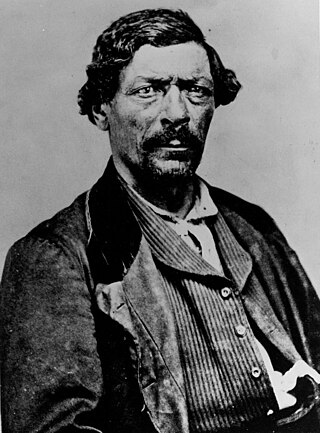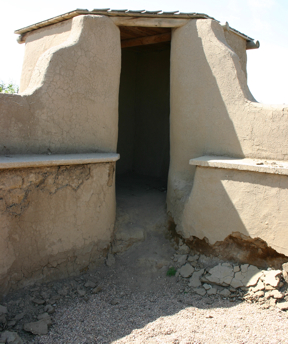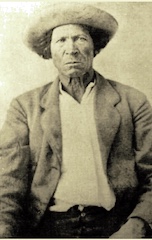Related Research Articles

Colorado City is a census-designated place (CDP) and post office in and governed by Pueblo County, Colorado, United States. The CDP is a part of the Pueblo, CO Metropolitan Statistical Area. The Colorado City post office has the ZIP Code 81019. At the United States Census 2020, the population of the Colorado City CDP was 2,237. The Colorado City Metropolitan District provides services.

James Pierson Beckwourth was an American fur trapper, rancher, businessman, explorer, author and scout. Known as "Bloody Arm" because of his skill as a fighter, Beckwourth was of multiracial descent, being born into slavery in Frederick County, Virginia. He was eventually emancipated by his enslaver, who was also his father, and apprenticed to a blacksmith so that he could learn a trade.

John David Albert was an American mountain man.

Charles Bent was an American businessman and politician who served as the first civilian United States governor of the New Mexico Territory, newly invaded and occupied by the United States during the Mexican-American War by the Military Governor, Stephen Watts Kearny, in September 1846.

Fort Vasquez is a former fur trading post 35 miles (56 km) northeast of Denver, Colorado, United States, founded by Louis Vasquez and Andrew Sublette in 1835. Restored by the Works Progress Administration in the 1930s, it now lies in a rather incongruous position as U.S. Route 85 splits to run either side of the building. History Colorado took possession of the property in 1958 and runs it as a museum to display exhibits of the fur-trade era.
Andrew Whitley Sublette or also, spelled Sublett, was a frontiersman, trapper, fur trader, explorer, mountain man and brother to William, Milton, and Solomon, helped establish a trading post with Louis Vasquez in 1835. The present day, Fort Vasquez, located on Highway 85, next to Platteville, Colorado, is a reconstruction. After selling the trading post in 1840, Andrew left the mountains and was seen in El Pueblo around 1844 and 1845, traveling along the Arkansas River, following herds of American Bison.
Marcelino Baca was a 19th-century Mexican fur trader who helped to establish the fur trade in the American Southwest.

The Trapper's Trail or Trappers' Trail is a north-south path along the eastern base of the Rocky Mountains that links the Great Platte River Road at Fort Laramie and the Santa Fe Trail at Bent's Old Fort. Along this path there were a number of trading posts, also called trading forts.
Fort Le Duc or Fort LeDuc was a square fort and trading post built near Wetmore, Colorado. It was named after trapper Maurice LeDuc or Maurice LeDoux, and constructed around 1830 or 1835.

The Taos Mountain Trail was the historic pathway for trade and business exchanges between agrarian Taos and the Great Plains (Colorado) from pre-history through the Spanish Colonial period and into the time of the European and American presence. The Taos Mountain Trail, between northern New Mexico and southern Colorado, connected the high mountain traders and their trading partners north and south of the Sangre de Cristo Mountains. Also called the Trapper's Trail, the pathway was only wide enough for people on foot or horses in single file, but it shortened a trip from Taos to the plains farther north from nearly two weeks to three days in good weather. The Taos Mountain Trail was also known as the Sangre de Cristo Trail and the Aztec Trail.

The early history of the Arkansas Valley in Colorado began in the 1600s and to the early 1800s when explorers, hunters, trappers, and traders of European descent came to the region. Prior to that, Colorado was home to prehistoric people, including Paleo-Indians, Ancestral Puebloans, and Late prehistoric Native Americans.
The Fort Pueblo massacre was an attack that occurred on December 25, 1854, against Fort Pueblo, Colorado, also known as El Pueblo, a settlement on the north side of the Arkansas River, 1⁄2 mile west of the mouth of Fountain Creek, above the mouth of the Huerfano. The attack followed the deaths of Chief Chico Velasquez and others who died of smallpox after having been given blanket coats which the Muache believed had been deliberately contaminated. Coalition forces of over 100 Muache Utes and Jicarilla Dindes under the leadership of Chief Tierra Blanco led the attack against Fort Pueblo, killing 15 men, and capturing one woman, and two boys. Later on, the Muache killed the woman south of Pueblo along Salt Creek. Two women and one man survived the joint military operation, and the two boys who were captured eventually returned.

Maria Teresa "Teresita" Sandoval Suazo (1811–1894) was among the first women of European heritage to live in the Arkansas Valley of present-day Colorado. She is one of the founders of El Pueblo in the current city of Pueblo, Colorado. She managed a ranch, the Doyle Settlement, in her later years.
The Turley Mill and Distillery Site is a historic site on the Rio Hondo about 11 miles (18 km) north of Taos, New Mexico. It was a mill and distillery which served as the headquarters of Simeon Turley's commercial and manufacturing empire. Simeon Turley (1809–1847) and his brothers Stephen Turley (1786–1851) and Jesse B. Turley (1801–1861) transported goods from Franklin, Missouri to Taos via wagon train on the Santa Fe Trail. About 1827–1829 Simeon settled in Arroyo Hondo and established the mill and distillery as a popular trading post and "watering hole." Simeon was murdered in the Taos Revolt of January 1847 and the mill and distillery site was all but destroyed. Simeon Turley is buried in the Kit Carson Memorial Cemetery in Taos. The mill and distillery site was listed on the State of New Mexico Register of Cultural Properties in 1969 and on the National Register of Historic Places in 1978.

Charles Autobees (1812–1882), whose last name was also spelled Urtebise and Ortivis, was a fur trader and pioneer in the American Old West. He was the founder of Autobees, Colorado.
El Pueblo, also called Fort Pueblo, was a trading post and fort near the present-day city of Pueblo in Pueblo County, Colorado. It operated from 1842 until 1854, selling goods, livestock, and produce. It was attacked in 1854, killing up to 19 men and capturing three people. A recreation of the fort is located at the El Pueblo History Museum at the site of the original fort.
Milk Fort, also known as Fort Leche, Pueblo de Leche, Fort El Puebla, Peebles Fort, and Fort Independence was a trading post and settlement in Otero County, Colorado in the late 1830s. There are no remains of the settlement.
Hardscrabble was a settlement established by traders and trappers in the 1840s near the fork of Adobe and Hardscrabble Creeks in present-day Fremont County, Colorado. It was called San Buenaventura de los Tres Arrollos—for three creeks Newlin, Adobe, and Hardscrabble—by its founders, George Simpson, Joseph Doyle, and Alexander Barclay. The name Hardscrabble became more common.
Alexander Barclay was an American frontiersman. After working in St. Louis as a bookkeeper and clerk, he worked at Bent's Old Fort. He then ventured westward where he was a trapper, hunter, and trader. Barclay entered into a common-law relationship with Teresita Sandoval, one of the founders of the settlement and trading post El Pueblo. He helped settle Hardscrabble, Colorado and built Fort Barclay in New Mexico.

The Greenhorn Valley lies in southern Pueblo County, Colorado just east of Greenhorn Mountain. It includes the communities of Colorado City and Rye.
References
- ↑ Lecompte, Janet (1978). Pueblo, Hardscrabble, Greenhorn. Norman: University of Oklahoma Press. pp. 42–43, 73. ISBN 0806117230.
- ↑ MacKell, Jan (2004). Brothels, Bordellos, and Bad Girls. Albuquerque: University of New Mexico Press. pp. 107–108. ISBN 9780826333421.
- ↑ Lecompte 1978, pp. 139–140.
- ↑ Lecompte 1978, pp. 139–146, 166.167.
- ↑ Dodds, Joanne West. "Greenhorn Chronology". Greenhorn Valley History. Pueblo City-County Library. Retrieved 2 November 2022.
- ↑ Lecompte 1978, pp. 219–220.
- ↑ Broadhead, Edward (May 2017). "The Story of John Brown". Desert-Gazette. Retrieved 28 October 2022. Reprinted from "The Pueblo Lore," Pueblo County Historical Society
- ↑ Lecompte, Janet. "Manco Burro Pass massacre". New Mexico Historical Review. University of New Mexico. Retrieved 1 November 2022.
- ↑ Broadhead 2017, p. .